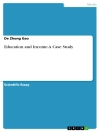Essay from the year 2017 in the subject Communications – Miscellaneous, grade: A, , language: English, abstract: This paper analyses the representation of Muslim women in American and Canadian media. First of all, the paper highlights the representations of Muslims as a whole, followed by an analysis of the representation of Muslim women in particular.
The paper also discusses Muslim women’s identities and the veiling practice from their perspectives. Taking into consideration the limitations of previous studies, the paper then proposes various tools or lenses to help with thinking about the identity of Muslim women. Lastly, the paper outlines the positive and negative outcomes of media (mis)representation. Critical analysis has been used as a methodology to uncover oppressive discourse and portrayals when constructing “the other.” Edward Said’s postcolonial criticism of the “Other” and Agenda Setting Theory influenced the theoretical framework.
Sobre el autor
Biography
Afnan Qutub is an Interpersonal Communication lecturer at King Abdulaziz University in Saudi Arabia. She has a master’s degree in Communication Studies from California State University in the United States. She is currently completing a Ph D degree at the University of Leicester. Her research interests include media representations, interpersonal communication, and critical and cultural studies. In 2013, she published “The Doodling Psychology: Are Doodling Students More Engaged or Distracted?” for the The International Journal of Literacies, as well as “Harem Girls and Terrorist Men” in Colloquy in 2012.












